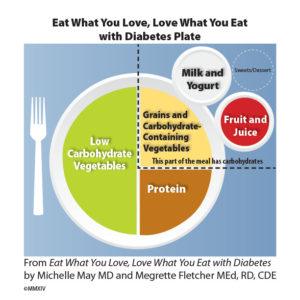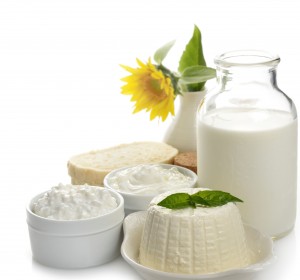 The carbohydrates in the foods you eat and the beverages you drink affect your blood sugar levels. Therefore, when you have diabetes, it’s important to be aware of where carbohydrates are found in your diet. The Eat What You Love, Love What You Eat with Diabetes Plate offers a quick reference for this information.
The carbohydrates in the foods you eat and the beverages you drink affect your blood sugar levels. Therefore, when you have diabetes, it’s important to be aware of where carbohydrates are found in your diet. The Eat What You Love, Love What You Eat with Diabetes Plate offers a quick reference for this information.
In the upper right-hand corner, you can see that carbohydrates are found in:
- Grains
- Carbohydrate-containing vegetables
- Milk and yogurt
- Fruit and juice
- Sweets/desserts
You’ll remember from Eat What You Love, Love What You Eat with Diabetes that the reference serving sizes each carbohydrate choice contain 15 grams of carbohydrate. That makes it easy to count carbs in your snacks and meals.
One cup (8 ounces) of regular, 2%, 1%, or skim cow’s milk has approximately 15 grams of carbohydrate. 6 ounces (3/4 cup) plain or light yogurt also has about 15 grams of carbohydrate. But why doesn’t all dairy count as carbs?
What about all of those other dairy products?
 But what about all of the other foods found in the dairy case like cream cheese, half and half, sour cream, cheese, cottage cheese, and eggs? Although these items are found in the “Dairy” section, they don’t contain a significant amount of carbohydrate. Depending on the item, they’re considered either a fat choice or a protein choice. (And of course, since eggs are not from cows, they’re not dairy products either, but that’s another topic!)
But what about all of the other foods found in the dairy case like cream cheese, half and half, sour cream, cheese, cottage cheese, and eggs? Although these items are found in the “Dairy” section, they don’t contain a significant amount of carbohydrate. Depending on the item, they’re considered either a fat choice or a protein choice. (And of course, since eggs are not from cows, they’re not dairy products either, but that’s another topic!)
What is a fat choice?
Here are a few examples of fat choices from the dairy case: 1 tablespoon of cream cheese, 2 tablespoons of half-and-half cream, 2 tablespoons of sour cream. This amount of food contains 5 grams of fat per serving.
What is a protein choice?
An example of a protein choice from the dairy case is 1 ounce of cheese, a quarter cup of cottage cheese, or 1 egg. This amount of food contains 7 grams of protein per serving size listed. The amount of fat varies depending on the food selected.
How do these other dairy products fit into your diet when you have diabetes? Well the good news is that since they don’t have many carbs, they won’t raise your blood sugar significantly when eaten in moderation. However, milk-based foods are animal products so they may contain saturated fats which may contribute to the risk of heart disease if eaten in excess. Including these foods in your diet is certainly still possible. Balance, variety, and moderation is the key.
When eating mindfully, remember you are in charge. You can choose what you want to eat. Eating slowly and noticing your changing sense of fullness can help you not overfill your stomach. Remind yourself that you can modify your food choices within a meal to keep your diet balanced. Awareness of nutrition facts is helpful to choose the foods you love. As Michelle May, MD, says, “Nutrition is a tool, not a weapon.”
